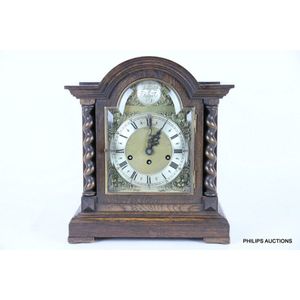Junghans Wurttemberg Westminster Chime Mantle Clock
You must be a subscriber, and be logged in to view price and dealer details.
Subscribe Now to view actual auction price for this item
When you subscribe, you have the option of setting the currency in which to display prices to $Au, $US, $NZ or Stg.
- Chapter Ring - A separate metal plate on the face of a clock, on which the numerals for the hours and sometimes parts of the hours, are displayed, usually wheel shaped and sitting on top of the dial plate. The chapter ring is often a feature of the clock and can be silvered or enamelled to stand as a contrast to its background. The hours are usually shown in Roman numerals, although in the late 19th and earlt 20th century, Arabic numerals became fashionable.
- Spandrel - An architectural term that in horology refers to the triangular ornamental decoration in the corners of of the dial plate. The spandrels are usually of cast brass and may be additonally chased and engraved. On painted dial clocks the spandrels are also usually painted.
- Back Plate - On many types of clocks, the movement operates between two plates, usually made of brass, one at the back, and the other at the front, which forms a mount for the dial.
On English bracket, mantle and table clocks the backplate was often visible through a glass door or panel from the late 17th century, and could be profusely engraved with scrolling decorations, flowers, foliage, birds, and figures. The engraving could also include the maker?s name.
The amount of engraving reduced and became simpler as the 18th century progressed, and by 1800, had been reduced to a border, often with the maker's name in the centre. By the early 1800s all decoration had ceased, and only the maker's name was added, and by the Victorian era, most bracket, mantle and table clocks had no engraving.
This item has been included into following indexes:
Visually similar items

An American oak mantle clock, late 19th century, with maker's trademark for Seth Thomas, the architectural gong and bell strike clock with a stepped pediment above the plinth enclosed dial with Roman numerals set within a decorative gilded bezel, and raise

A 19th century walnut and oak cased single fusee bracket clock, signed Richard Hughes, Carnarvon, the silvered Roman numeral chapter ring with arcaded seconds and subsidiary date dial, on an engraved brass background with applied Arabesque ornamentation, (

A George III bracket clock, John Holmes, London, circa 1800, the brass lined shallow break arch ebonised case with handle to the triple pad top, glazed, brass rimmed panels to each side. The circular enamel dial with inner Roman numerals and an outer minut

Marble portico clock with a glass casing, enamelled landscape skirt & gilded finials, with a key & pendulum. Height 43 cm
